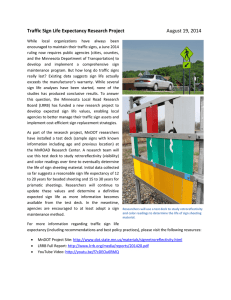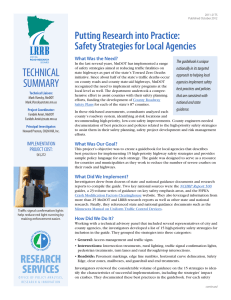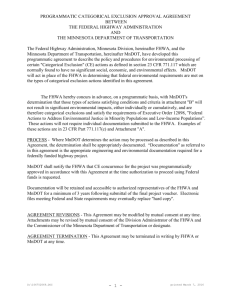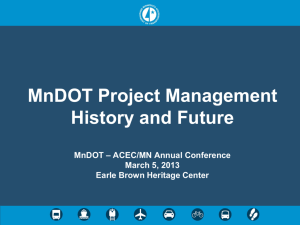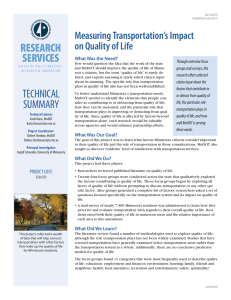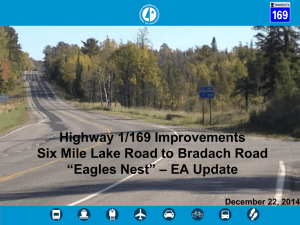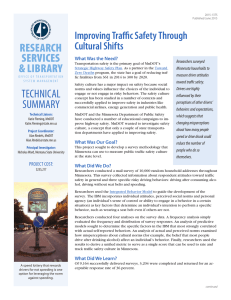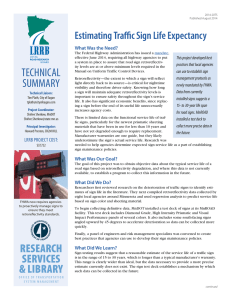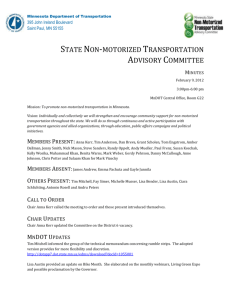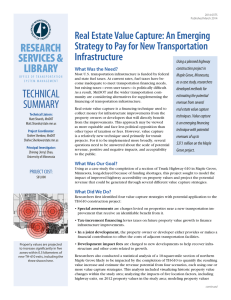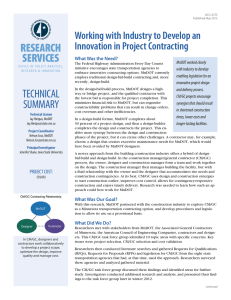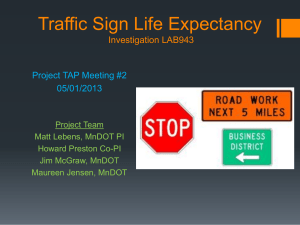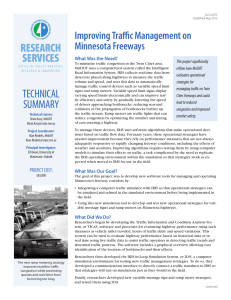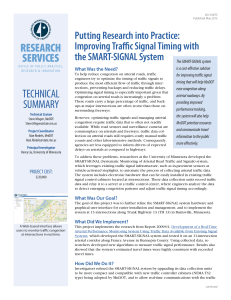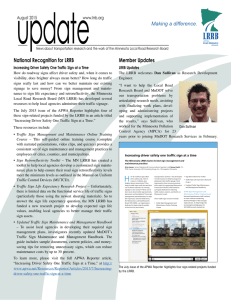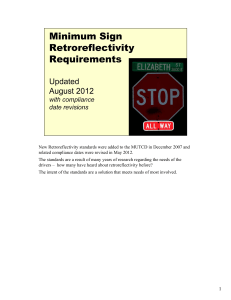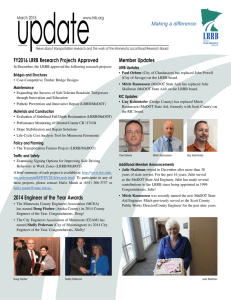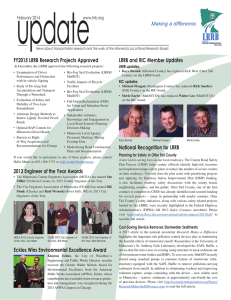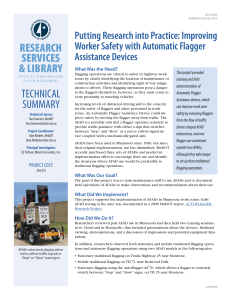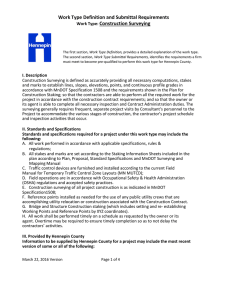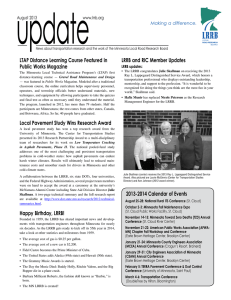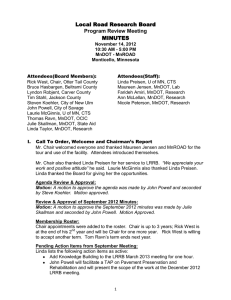Updated Guide Helps Agencies Meet FHWA Sign Maintenance Requirements
advertisement
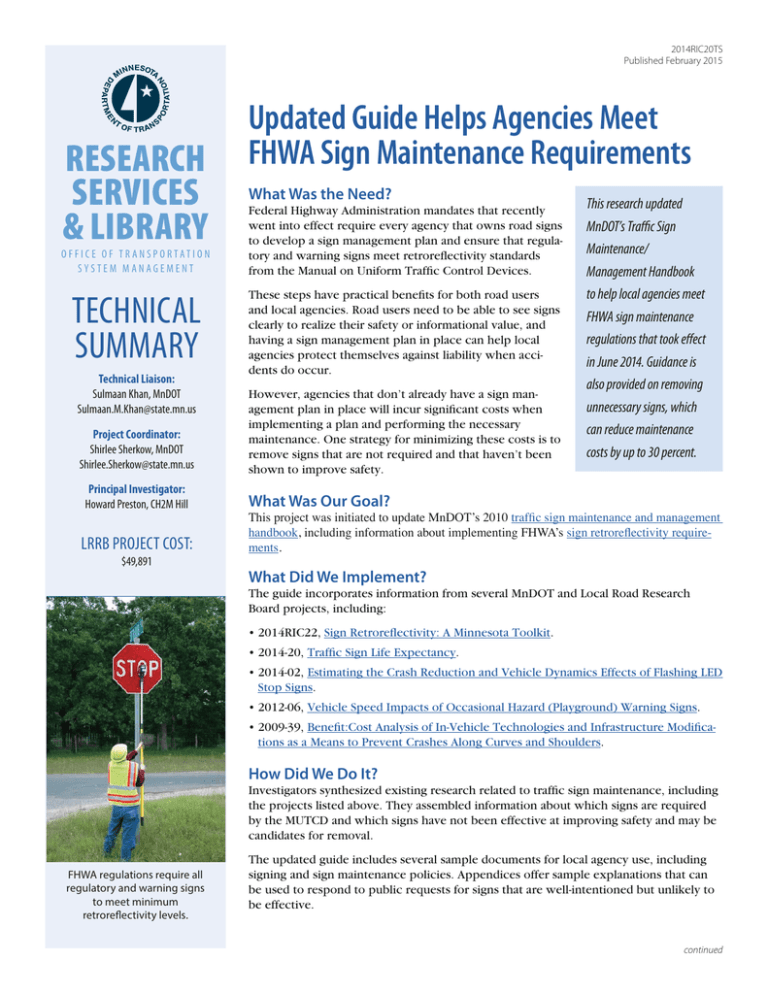
2014RIC20TS Published February 2015 RESEARCH SERVICES & LIBRARY O FFICE O F TR ANSP O R TATI O N SYSTEM MANAGEMENT TECHNICAL SUMMARY Technical Liaison: Sulmaan Khan, MnDOT Sulmaan.M.Khan@state.mn.us Project Coordinator: Shirlee Sherkow, MnDOT Shirlee.Sherkow@state.mn.us Principal Investigator: Howard Preston, CH2M Hill LRRB PROJECT COST: $49,891 Updated Guide Helps Agencies Meet FHWA Sign Maintenance Requirements What Was the Need? Federal Highway Administration mandates that recently went into effect require every agency that owns road signs to develop a sign management plan and ensure that regulatory and warning signs meet retroreflectivity standards from the Manual on Uniform Traffic Control Devices. These steps have practical benefits for both road users and local agencies. Road users need to be able to see signs clearly to realize their safety or informational value, and having a sign management plan in place can help local agencies protect themselves against liability when accidents do occur. However, agencies that don’t already have a sign management plan in place will incur significant costs when implementing a plan and performing the necessary maintenance. One strategy for minimizing these costs is to remove signs that are not required and that haven’t been shown to improve safety. This research updated MnDOT’s Traffic Sign Maintenance/ Management Handbook to help local agencies meet FHWA sign maintenance regulations that took effect in June 2014. Guidance is also provided on removing unnecessary signs, which can reduce maintenance costs by up to 30 percent. What Was Our Goal? This project was initiated to update MnDOT’s 2010 traffic sign maintenance and management handbook, including information about implementing FHWA’s sign retroreflectivity requirements. What Did We Implement? The guide incorporates information from several MnDOT and Local Road Research Board projects, including: • 2014RIC22, Sign Retroreflectivity: A Minnesota Toolkit. • 2014-20, Traffic Sign Life Expectancy. • 2014-02, Estimating the Crash Reduction and Vehicle Dynamics Effects of Flashing LED Stop Signs. • 2012-06, Vehicle Speed Impacts of Occasional Hazard (Playground) Warning Signs. • 2009-39, Benefit:Cost Analysis of In-Vehicle Technologies and Infrastructure Modifications as a Means to Prevent Crashes Along Curves and Shoulders. How Did We Do It? Investigators synthesized existing research related to traffic sign maintenance, including the projects listed above. They assembled information about which signs are required by the MUTCD and which signs have not been effective at improving safety and may be candidates for removal. FHWA regulations require all regulatory and warning signs to meet minimum retroreflectivity levels. The updated guide includes several sample documents for local agency use, including signing and sign maintenance policies. Appendices offer sample explanations that can be used to respond to public requests for signs that are well-intentioned but unlikely to be effective. continued “This guide was needed because there was confusion related to the new FHWA sign maintenance mandates. This update includes the new regulations and best practices for satisfying them.” Watch for Children signs have not been shown to be effective at improving safety or changing driver behavior, and may actually give parents a false sense of security. According to this research, agencies should consider removing these and other ineffective signs. —Sulmaan Khan, What Was the Impact? Assistant Project Development Engineer, MnDOT State Aid for Local Transportation The guide synthesizes best practices related to sign maintenance in several areas: • Methods for assessing sign condition and maintaining signs to necessary standards. • Budgeting for a sign maintenance program, with examples for cities with a population under 5,000; cities with a population over 5,000; and townships and counties. • Policy development. • Implementation of a sign maintenance policy. “Many signs have not been proven to be effective at much of anything except increasing maintenance costs, and eliminating those signs has in some cases reduced costs by 30 percent.” —Howard Preston, Senior Transportation Engineer, CH2M HILL Some of the types of signs that could potentially be removed to make sign maintenance more affordable include stop signs at extremely low-volume intersections (which do not improve safety and are rarely obeyed) or Watch for Children signs (which provide no enforceable guidance and are generally ignored by drivers). In a pilot implementation of these guidelines in Stevens County, Minnesota, 30 percent of signs were removed with a corresponding 30 percent decrease in maintenance costs. If all local agencies adopt this approach, total cost savings in Minnesota could be tens of millions of dollars per year. While many agencies are concerned about legal charges of negligence if a traffic accident occurs at a location where a sign has been removed, Minnesota tort law provides agencies immunity against such claims if they remove signs in accordance with their signing and sign maintenance policies or if the agency’s actions are documented and based on engineering judgment. Four case studies demonstrate these concepts. What’s Next? MnDOT has sent a copy of the guide to every county and State Aid city in the state. Researchers have conducted three daylong workshops around the state on the guide that have been attended by about 125 people. The guide has also been presented at other conferences, including meetings of the American Public Works Association, City Engineers Association of Minnesota and the Iowa Local Technical Assistance Program. Many of the signs requested by the public and often installed by agencies have not been thoroughly evaluated. Research that definitively establishes their effectiveness—or ineffectiveness—to influence driver behavior and improve safety may be useful. Produced by CTC & Associates for: Minnesota Department of Transportation Research Services & Library MS 330, First Floor 395 John Ireland Blvd. St. Paul, MN 55155-1899 651-366-3780 www.mndot.gov/research Continued research on the life span of traffic signs will be useful for agencies responsible for maintaining them. A test deck installed at MnROAD will ultimately provide this information. This Technical Summary pertains to the LRRB-produced implementation product 2014RIC20, “Minnesota’s Best Practices for Traffic Sign Maintenance/Management Handbook,” published October 2014. The full report can be accessed at http://www.lrrb.org/PDF/2014RIC20.pdf.
